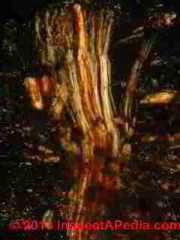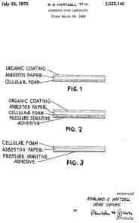 Asbestos Heat & Sound Insulation
Asbestos Heat & Sound Insulation
Asbestos Insulation Products
- POST a QUESTION or COMMENT about what building materials may contain asbestos, visual identification of asbestos-containing materials in buildings, and possible asbestos material identification by testing, use, age, appearance
Asbestos insulation:
History, manufacture, visual identification: how to recognize asbestos heat & sound insulation in buildings - a visual guide to identifying asbestos in buildings.
This articles series about the manufacture & use of asbestos insulation and related asbestos-containing products includes detailed information on the production methods, asbestos content, and the identity and use of asbestos-containing materials. Page top photo: asbestos paper machine, finishing end. This machine produced rolls of asbestos paper at a rate of 50 tons in 24 hours. The last reel of asbestos paper (shown) weighed 2,500 to 3000 lb.
InspectAPedia tolerates no conflicts of interest. We have no relationship with advertisers, products, or services discussed at this website.
- Daniel Friedman, Publisher/Editor/Author - See WHO ARE WE?
Asbestos Heat & Sound Insulation Product History & Manufacturing Processes
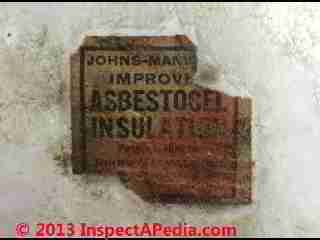 The following text is Adapted from Rosato (1959) p. 94-105 [1] © 2021 InspectApedia.com
The following text is Adapted from Rosato (1959) p. 94-105 [1] © 2021 InspectApedia.com
Asbestos Insulation Article Series Contents
- ASBESTOS INSULATION
- ASBESTOS BOILER INSULATION
- ASBESTOS BUILDING INSULATION
- ASBESTOS FIREPROOFING SPRAY-On Coatings
- ASBESTOS IN MINERAL WOOL / STONE WOOL
- ASBESTOS PAPER DUCT INSULATION
- ASBESTOS PIPE INSULATION
- ASBESTOS STYROFOAM PANELS
- ASBESTOS IDENTIFICATION IN BUILDINGS
- ASBESTOS OTHER PRODUCTS
- VERMICULITE INSULATION
- REFLECTIVE INSULATION
Asbestos insulation was produced in the form of asbestos papers, corrugated asbestos papers, asbestos-cement millboards, and asbestos-enriched fiber molded products. These developed into a large and valuable industry principally because of their heat and sound insulation combined with their incombustibility.
At left: label from asbestos pipe insulation, a Johns-Manville product, collected by the D. Friedman and photographed in our laboratory.
Chrysotile asbestos is the principal source for the insulation material. The Grade 5 Canadian fibers are generally referred to as asbestos paper products.
Blue Asbestos Sheet & Board Products
Sheets or boards made from blue asbestos are not very suitable for either heat or electrical insulation. These types of fibers are apt to be too stratified and do not provide sufficient strength to resist puncture at the higher temperatures.
Examples of Types of Asbestos Insulation
Examples of types of asbestos insulation are: outer jackets for industrial furnaces, linings for safes or fire-doors, pipe insulation, electric heaters, incinerators, drying ovens, incubators, locomotives, panelling for garages, storage bins for combustibles, automobile hoods, electrical switch rooms, electrical apparatus, packings, gaskets, etc.
Naval ships use large quantities of asbestos insulation. The United States Navy has been one of the prime movers in the development of asbestos heat and electrical insulation. Asbestos has a distinct advantage as heat-insulation material inasmuch as it can be converted to a very loose state.
It will retain this form even at continuous temperatures as high as 700 11 C. The insulating agent in these products is really the trapped air.
 Asbestos is of little use as an insulator at low temperatures when atmospheric moisture condenses on it. Wet
asbestos, even in a loose form, ceases to be an insulator.
Asbestos is of little use as an insulator at low temperatures when atmospheric moisture condenses on it. Wet
asbestos, even in a loose form, ceases to be an insulator.
For low temperature or cold insulation, the air bubbles within the insulator have to be completely sealed off and protected against absorption of water with such water proofing materials as asphalt, silicates, and cements.
When reviewing the subject of insulation, it is important to appreciate both temperature and time conditions. Generally, insulation such as the type used for pipes and ovens concerns long time exposures which can range from one to twenty years.
At left our photo illustrates asbestos insluation on the exterior of a heating boiler.
Details are at ASBESTOS BOILER INSULATION.
However, it is important to appreciate that insulation requirements also exist for such extremely short time conditions as those encountered in modern day rockets and missiles.
These types of insulation products generally have no similarity to the longer time conventional type of insulators.
Asbestos-phenolic molded plastic insulators are presently being used in rockets and missiles where temperature conditions ranging from 3,000 to 20,000°F are encountered. Time durations range from seconds to minutes. A review of these types of insulators is given in the chapter on plastics.
Asbestos insulations are very diversified. In most cases, the fibers are combined with other such lightweight materials as magnesium carbonate (85 per cent magnesia).
With wet process insulating materials, small quantities of clay are added as a binder and in some cases silicates are added. Insulation on steam-pipes can be applied wet. They are bound with clay, silicates, or similar binding materials. Drying is effected by the application of steam through the pipes.
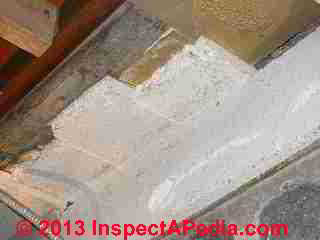 In order to reduce the cost and the time for installing continuous
sheet asbestos, methods have been devised where
asbestos is sprayed on walls and ceilings.
In order to reduce the cost and the time for installing continuous
sheet asbestos, methods have been devised where
asbestos is sprayed on walls and ceilings.
See ASBESTOS FIREPROOFING SPRAY-On Coatings
Asbestos applied in this manner provides for thermal insulation, fire protection, sound insulation, resistance to corrosion when metal surfaces are covered, and elimination of wall "sweating." For sound insulation and acoustical purposes, fiber up to 1 /2 in. in length is used.
Photo at left: nearly pure tremolite asbestos insulating blocks glued to the basement ceiling of a commercial building in White Plains, NY © Daniel Friedman.
Silicates have been the primary binders for paper.
Asbestos corrugated paper is made by crimping ordinary asbestos paper and pressing it into permanent corrugated shapes.
Depth of corrugation is approximately one-quarter inch. The sheets of the corrugated paper are covered with flat asbestos cement sheets to form sandwich structures.
The nodes of the corrugated sheets are treated with sodium silicate to provide for adhesion. This type of insulation provides for large volumes of dead air space; it is sometimes referred to as asbestos air cell insulation.
Asbesos miliboard is generally classed with paper inasmuch as it is actually a thick asbestos paper, just as cardboard is considered a thick wrapping paper.
The miliboard is a rigid type of asbestos board insulation that cuts or drills easily and can be nailed or screwed to supporting beams. It can withstand temperatures up to 1,000°F without smoking.
Also see ASBESTOS IN MINERAL WOOL / STONE WOOL
Table of Known Asbestos Building Insulation Manufacturers & Products
Asbestos Product Manufacturer |
Asbestos Insulation Product Name |
| Allis Chalmers Corporation | on boilers, turbine engine parts |
| American Standard | on boilers |
| American Steel & Wire Co | on electrical wire |
| Anco Insulation Corporation, | on automotive products |
| A.P. Green Co. | insulation adhesives & coatings Kast-O-Lite SK7 Thermo-Flake |
| Aqua-Chem | on boilers |
| Armstrong Co. | insulating coatings Duplex Wool Felt Pipe Insulation Kaylo Pipe Covering Armstrong Limpet LW25 Raw Asbestos Fiber Armstrong Limpet Spray Armstrong LK Block |
| Armstrong Contracting and Supply - ACS | Hi-Temp |
| Kaylo | |
| Limpet | |
| Baldwin-Ehret-Hill Co | Enduro Block Insulation Enduro Block Insulating Cement Monoblock Pyrospray Super Powerhouse Thermalite |
| Celotex | Careytemp |
| Cleaver Brooks | on boilers |
| Columbia Boiler Co | on boilers |
| Combustion Engineering | on boilers |
| Crown Cork & Seal | Mundet |
| Eagle Pitcher | Hylo OneCote Super 66 Supertemp |
| M.H Detrick | Detrick |
| Federal Mogul | Kaytherm |
| Forty Eight Co. | 48 Block Insulation |
| Foster Wheeler | on boilers |
| GAF | Calsilite Hearthglow Ruberoid Vermont 7-M |
| GE General Electric | on electrical wire |
| General Refractories | Di-Asbestos Grefco |
| Johns Manville JM Corp | Thermobestos |
| J.T. Thorpe | distribution & installation |
| Kaiser Aluminum | Vee-Block |
| Keasby & Mattison | Hy-Temp Kaytherm |
| Keene | Enduro Mono-Spray Styltone Uni-Coustic |
| Kewanee | on boilers |
| National Gypsum | Gold Bond |
| Nicolet | Hy-Temp |
| Owens Corning | AirCell F1 Thermal Kaylo pipe insulation |
| Parsons | on boilers |
| Pfizer | Kilnoise |
| Philip Carey | Carey 7m other products |
| Pittsburgh Corning | Unibestos |
| Plant Rubber & Asbestso Co. | PABCO Caltemp |
| Plibrico | Plisulate |
| Proco | Jones-Blair Bloc Seal |
| Rock Wool Mfg. Co. | Delta Maid Insulating Cement |
| Rockbestos | Rockbestos cloth |
| Saint Gobain | Wanner Isofi other products |
| Synkloid | Eze-Tex Flexi-Patch |
| Unarco | Unibestos |
| Union Carbide | Calidria |
| United States Mineral | CAFCO J-spray |
| US Gypsum | on boilers on pipes |
| Weil McLain | on boilers |
| W.R. Grace | Monokote |
| Zonolite | |
| Zurn | on boilers |
Notes to the table above:
See details at ASBESTOS PRODUCING COMPANIES & TRUSTS
Asbestos Paper & Paper Insulation Manufacture, Properties, Uses
Two standard types of paper machines are used to manufacture various asbestos paper products.
These machines are typical of the standard pulp paper making machines; i.e., the Fourdrinier machine and the cylinder machine. Typical of the pulp paper business, modifications have been made on these types of machines in manufacturing asbestos products. The more general type of paper asbestos making machine used is the cylinder.
At left: asbestos fibers collected from a sample of asbestos paper duct wrap, taken through our lab microscope [DF].
The standard method of making paper is essentially the same for all types of machines.
The web of paper is first formed on a traveling wire in the case of the Fourdrinier, or on a cylinder mold of the cylinder machine.
The wet sheet is further dewatered by the press section of the machine, dried out by various types of dryers and finished or smoothed out by calenders.
Fourdrinier Paper Machine for Making Asbestos Paper Products
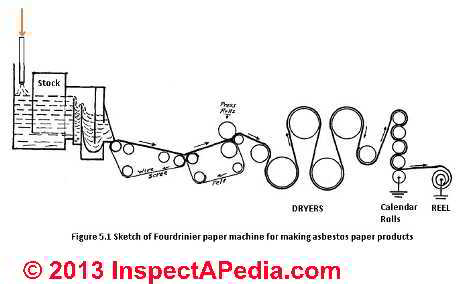 A sketch of the Fourdrinier
machine is shown in Figure 5.1 at left [click to enlarge]. The asbestos fiber which
goes into the paper machine beaters is very finely ground.
A sketch of the Fourdrinier
machine is shown in Figure 5.1 at left [click to enlarge]. The asbestos fiber which
goes into the paper machine beaters is very finely ground.
During the processing of the stock, extreme care is taken in order to eliminate impurities and knots. Sometimes the stock is sent through a sand trap and strainers before it passes onto the paper machine.
Water is the medium used to carry the asbestos pulp. This water, generally referred to as white water, is recirculated through the paper machine.
When the stock is initially made, it can contain approximately three per cent fiber. After it has left the stock chest, where it initiates, the high fiber content stock is diluted with white water to a stock of approximately one-half per cent.
The stock chests are cylindrical in shape. They are lined with noncorrosive metal to minimize contamination of stock. Agitators keep the stock moving and also provide for correct consistency.
By gravity, the stock is deposited on a wire screen.
A large percentage of the water drains from the stock through the wire screen and through suction boxes or rolls located next to the stock being carried over the wire screen. Generally, the stock is carried from the wire screen to woolen felts. The felt is an endless blanket similar to the wire screen which is also endless.
These materials continually move and carry the paper pulp. During this operation, the paper stock can be pressed between one or more sets of pressure rolls.
After this operation it is carried around steamed-ash heated dryers where the stock which is approximately 60 per cent dry becomes 95 per cent dry.
Felts are also used to carry the paper around the dryers. The next step is for the paper to go through calenders where it is given a smooth surface. The product is finally wound on a reel which completes its cycle. See Figure 5.2.
Figure 5.2. (Courtesy Johns-Manville Corp.)
Asbestos paper machine (finishing end) . This machine produces about 50 tons of paper in 24 hr. The last reel weighs 2,500 to 3,000 lb.
Paper sheets have been made using all asbestos fiber or the various mixes such as asbestos pulp, asbestos sisal, asbestos glass, etc. Inasmuch as asbestos is an extremely fine fiber, it provides for improved blendings of the thicker or coarser fibers.
Experience is required in order to determine the proper combination of fibers and to determine also the proper technique of producing suitable asbestos paper products.
Control of the white water is important in order to reduce fiber waste in the mill. However, it is also important to recognize that the amount of short fiber in the white water will affect the solidity of the finished paper product.
Modern paper machines have reclaiming systems; very little fiber is lost and the recirculated fiber is used to its maximum efficiency.
Cylinder Asbestos Paper Machine
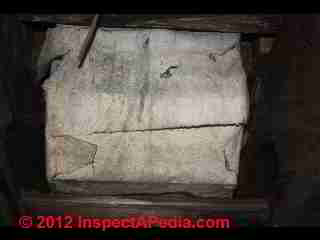 Various types of machines are
available which basically involve rotating cylinders.
Various types of machines are
available which basically involve rotating cylinders.
Asbestos stock is directed into a large vat which contains a revolving cylinder. The cylinder and vat should be made of noncorrosive material such as brass, copper or plastic.
As the cylinder rotates in the stock, fibers are collected on the cylinder. Various types of pulp beaters are available such as Hollander beaters. The beating or agitating action is generally performed by paddles located on the cylinder.
Photo at left illustrates asbestos paper used as heating duct wrap on the exterior of metal air ducts.
[Click to enlarge any image]
The paper stock which collects on the drum is passed onto a belt. Generally, the paper is sandwiched between two felts and directed over suction boxes in order to remove some of the water. The paper is directed through roller presses in order to continue to drive out the water.
Drying cylinders or. cans similar to the Fourdrinier machine are also used for removing most of the remaining water. Then, this paper is either rolled on reels or stacked. The thickness of the paper and its directional strength are affected by such variables as rotational speed of drum, type of agitation of the stock in the vat, and type or combination of fibers used.
Details about asbestos in or on HVAC ducts and similar products are at
- ASBESTOS DUCTS, HVAC
- ASBESTOS DUCT VIBRATION DAMPERS
- ASBESTOS PAPER DUCT INSULATION - where we include research on the history, uses, and and manufacture of asbestos paper and millboard.
- ASBESTOS PIPE-INSULATION
Asbestos Millboard Manufacturing Process Details
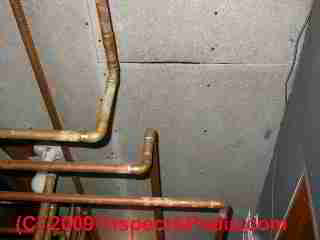 Rosato detailed the production of asbestos millboard. He described asbestos millboard as a "heat insulation" product, an apellation with which we disagree.
Rosato detailed the production of asbestos millboard. He described asbestos millboard as a "heat insulation" product, an apellation with which we disagree.
Because of its dense and cementious nature asbestos millboard, while fireproof, can conduct heat towards combustible materials that it might cover, such as wood framing.
Without an adequate air space or other insulation, heat conducted through non-combustible materials can still result in a fire. (Rosato 1959, 100-102)
Asbestos miliboard is made of very short asbestos fiber. The fiber must be uniformly fine and free from all foreign material and impurities. However, the uniformity of fiber is more critical in asbestos paper manufacture than in millboard manufacture. Asbestos fiber is placed in pulp beaters.
From the beater, the pulp moves to a stirring vat which is approximately three times larger than the beater. Buckets are used to remove the pulp or slurry from the vats to strainers. The pulp is subjected to varied screening and agitation in order to produce a homogeneous product.
After the filtering actions have been completed, the pulp is directed through pipelines to the millboard machine; this machine consists of a screen, press, and mold. The screening part consists of large boxes containing revolving screen drums. The watery mixture is kept moving with a paddle; it is filtered through the revolving screens.
The water is drained off through the interior of the boxes.
The next phase of the screening process involves draining the sheet by means of pressure applied by a conveyor belt on the screen. The conveyor belt carries the sheet to the pressing part of the machine. In the pressing operation, the porous conveyor belt moves under a pressing cylinder which squeezes out the water with high pressure.
Millboard machines are also available which contain more than one revolving screen. This type of machine provides for plying sheets at the pressing cylinder in order to produce thicker sheets.
The resulting plied sheet becomes homogeneous after the pressing operation.
The next important operation in the miliboard machine involves conveying the sheet to the molding cylinder. The molding cylinder is placed above the pressing cylinder. Both are connected by endless conveyor belts carrying the pulp layer from the pressing cylinder to the molding cylinder. The conveyor belt is carried along through the action of friction between the two cylinders.
Only the pressure cylinder is power driven. When the pulp comes in contact with the molding cylinder, it is transferred directly from the felt to the cylinder. This transfer occurs inasmuch as the adhesion to the wet surface of the cylinder is greater than the adhesion to the felt.
The molding cylinder determines the size and thickness of the millboard. Convolute wrapping of the pulp is done on the cylinder. Its circumference is generally equal to a single or double width of commercial millboard. Notches are located on the cylinder parallel to the direction of the axis so that when the miliboard has to be removed, a knife cut is made through the notch.
After the cutting operation, the sheets of asbestos pulp still contain a high percentage of water. Most of the water is removed by further pressing the sheets between rollers or in presses. The final operation involves subjecting the sheets to the drying process. Drying ovens are used where the sheets are either passed through on a continuous moving belt or suspended in the ovens. Drying temperatures are in the range of 180 to 200°F.
The pressing operation in the millboard machine is different from that of the paper machine. The thin papers can be pressed and dried much more thoroughly and rapidly than the miliboard.
In the commercial type of millboard machine, in order to produce one pound of finished miliboard, approximately 500 lb of water is required in the mixing vat. Means of conveying, storing, and pumping water are of major importance in this type of operation
Details about asbestos cement sheet products used in roofing, siding, and panels are provided
at CEMENT ASBESTOS SHEET PRODUCTS
Asbestos cement board is a hard cementious product easily distinguished by eye from more friable and dangerous soft asbestos panels used as building fireproofing such as these almost
pure TREMOLITE ASBESTOS CEILING PANELS.
More about this building material can also be read
at ASBESTOS FIREPROOFING SPRAY-On Coatings.
Asbestos Felt Manufacturing Procedure & Use in Roofing
Asbestos felt and papers impregnated with asphalt are used on the roofs of buildings and homes where resistance to outdoor weathering and insulation is important. The material, used as a flashing on walls, can be applied to concrete, brick, etc.
Ordinary roofing felts are made of vegetable fibers which are organic in composition and do not have the permanence of asbestos felts.
Roofing sheetscan be made up of single layers or plied
layers saturated, or coated or both saturated and coated
with asphalt compositions.
See CEMENT ASBESTOS SHEET PRODUCTS
In certain applications, such materials as wire reinforcements are added. The finished sheet materials are generally supplied as flat sheets or wound up in rolls. The application of these types of products to roofs, generally involves one layer of asphalt saturated rag felt, covered with asbestos perforated felt, and then completely coating the felts with asphalt.
The asphalt material suitable for impregnating felts is usually soft in consistency at room temperature, and ranges from semiliquids to semisolids. The types of asphaltic substance include pure native asphalts, residual asphalts, wood-tar pitch, sludge asphalt, and wurtzilite asphalt.
A white asbestos-coated roofing felt is made by hot pressure rolling a layer of asbestos felt onto asphalt-impregnated roofing paper. The layer is made water repellent and more adherent to the asphalt paper by impregnating the asbestos felt with 5 to 10 per cent stearic acid.*
* Clarvoe, G. W., (to Johns-Manville Corp.) U.S. Patent 2,593,010 (April, 1952).
Magnesia-Asbestos Insulation Manufacture & Properties
Magnesia-asbestos insulation is a very well known and popular product used for fire proofing and heat insulating. This type of insulation is generally identified by the name of 85 per cent magnesia.
Eighty-five per cent magnesia derives its name from the fact that it contains not less than 85 per cent of magnesium carbonate. Asbestos fiber is incorporated to act as a binding and reinforcing agent. The fiber principally used is chrysotile; crocidolite and amosite are used also.
The manufacturing process involves thorough mixing of he constituents with sufficient water to permit easy handling in a filter press. The products can be pressed into different shapes. Generally, three days in steam-heated kilns will dry out the product.
Its density is 12 lb per cu ft. In comparison, a solid block of magnesium carbonate weighs 130 lb per cu ft. The 85 per cent magnesia contains approximately only 10 per cent solid material by volume. The remaining 90 per cent is air and it provides for effective insulation.
This product produces exceedingly low thermal conductivity since its structure contains minute dead air cells formed by the interlocking crystals of magnesium carbonate. The product can withstand temperatures as high as 600°F without loss of any insulating value.
When it is subjected to alternate heating and cooling, it does not crack; it is not affected by structural changes which would change its insulating properties. Direct impingement of 2,000°F flame produces only small surface cracks. After 378 hr of intermittent immersion in boiling water no change was observed in its insulating effectiveness.
Average figures for thermal conductivity (K factor) follow. Thermal conductivity, Btu in. per hr per sq ft per °F:
Thermal Conductivity of Magnesia-Asbestos Insulation |
|
| 100 degF | /35 |
| 200 degF | .38 |
| 300 degF | .42 |
| 400 degF | .46 |
When insulation must operate above 600°F, it is used with diatomaceous silica insulation. Diatomaceous silica occurs naturally; it consists of fossilized plants called diatoms. These diatoms are mixed with asbestos fiber and the resultant insulation can be used in the range of 600°F to 1,000°F.
When the two materials are used together, the application is called combination insulation. The diatomaceous silicaasbestos insulation is applied to the hot surface in sufficient thickness to reduce the temperature at its outer surface to 600°F or lower.
Eighty-five per cent magnesia insulation is used as the outer insulation. This double layer construction effectively utilizes the greater heat resistance of diatomaceous silica as well as the lower thermal conductivity of 85 per cent magnesia.
Diatomaceous silica-asbestos blocks can weigh as much as 40 lb per cu ft. In order to reduce the weight, asbestos fiber, hydrated lime and diatomaceous silica have been used with binders of sodium silicate and calcium chloride. In one application, four parts of asbestos fiber and four parts 42-degree sodium silicate are slurried in fifty parts of water.
One part of calcium chloride dissolved in two parts of water is added and agitation is continued until the reaction is complete. A voluminous precipitate of calcium silicate in the hydrous form results from this reaction. At that point, two parts of diatomaceous silica and two parts of hydrated lime are introduced.
This mixture is run into the mold, the charge dewatered and pressure is applied. Weights as low as 20 lb per cu ft can be obtained with the usual hard diatomaceous silica type insulation.
Asbestos Spray-on vs Asbestos-Foam Laminate Insulation Products
Reader Question: was there asbestos used in spray foam insulation in the 1970's?
I was hoping you might be able to tell me if there was Asbestos used in spray foam for insulation in the 70's
My son in law passed from Mesethlioma last year and in the 70's when he was about 8-10 years old lived on a hippie commune where they built Domes out of fiberglass and steel and then sprayed the foam for insulation. This was in Warren County Virginia. - Anon. [by private email] 27 August 2015
Reply: use of asbestos in asbestos-foam laminate products
 Asbestos fireproofing spray material was used in buildings but as a "foam" product - not that I've come across.
Asbestos fireproofing spray material was used in buildings but as a "foam" product - not that I've come across.
See ASBESTOS FIREPROOFING SPRAY-On Coatings
To be clear, when wet, spray-on asbestos coatings looked "foamy" but this is not a plastic foam product such as UFFI, polystyrene, icynene, etc.
See also FOAM SPRAY INSULATION TYPES To recognize those.
There were in fact some asbestos foam and some asbestos-foam-laminate products or asbestos laminated to foam products; often asbestos material was laminated to a foam substrate as you will read below.
This is not the same fireproofing approach as spray-on asbestos coatings cited above.
The illustration of an asbestos-laminate foam product at left is from US4256799 A by Ohashi, published in 1981, filed in 1979 and cited in detail below. This was a multi-layer product incorporating asbestos paper as an upper layer (1), a matted or woven glass fiber as a middle layer, and a metal foil layer, with a foam core. The object was to construct a "fireproof" [sic] foam board type product.
Similarly, Gerek (1970) patented asbestos foam laminates illustrated just below.
A patent search for asbestos+foam finds:
- Gerek, G., and R. Hartzell. "Asbestos sheet material directly adhered to a cellular foam substrate." U.S. Patent 3,713,925, issued January 30, 1973.
- Gerek, Gene, and Rowland S. Hartzell. "Asbestos-foam laminates." U.S. Patent 3,522,140, issued July 28, 1970.
Abstract excerpt:
The present invention provides foam laminates of unique properties in which coated asbestos sheet material is adherently laminated to a cellular foam substrate.
[See the illustration at left] - Heckel, Johann. "Gas turbine with heat-insulating lining." U.S. Patent 4,300,349, issued November 17, 1981.
Abstract Excerpt:
For thermal insulation, the vaporizer which comprises two heated units advantageously has the feature that the casing is lined with asbestos foam on the inside. In this way, the energy requirement for operating the vaporizer is kept particularly low. - Newman, Arnold H. "Polypropylene microfoam." U.S. Patent 4,039,709, issued August 2, 1977.
This patent describes insulated wallpaper and cites US3522140 asbestos-foam laminates. - Ohashi, Takashi, Toru Okuyama, and Akira Suzuki. "A rigid foam core of a urethane-modified polyisocyanurate; construction materials; insulation; low density; asbestos, foils, and glass fiber layers." U.S. Patent 4,256,799, issued March 17, 1981.
Abstract Excerpt:
This invention relates to novel fireproof laminates using a urethane modified polyisocyanurate foam as a core material.
More particularly, it relates to fireproof laminates having excellent fireproof property and low-smoke development, which are obtained by using the above core material having a defined density and a front surface material having a three-layer structure composed of an asbestos paper as an upper layer, a glass fiber as a middle layer and a metal foil as a lower layer as a surface material for at least one side of the core material and piling them one upon another at a total thickness of a defined range through self-adhesion of the urethane modified polyisocyanurate foam. - Stein, Eckehard. "Vaporizer for generating developer gas, containing ammonia gas, from aqueous ammonia for developing diazo copying material." U.S. Patent 4,200,496, issued April 29, 1980.
[Cites an "asbestos foam liner" ] - Xanthos, Marinos, and Raymond T. Woodhams. "Chemically opening chrysotile asbestos and encapsulating." U.S. Patent 3,965,284, issued June 22, 1976.
Guides for Visual Identification of Asbestos-Containing Products Found On or In Buildings
- ASBESTOS IDENTIFICATION IN BUILDINGS provides a detailed guide to recognizing asbestos-containing materials in buildings and links to in depth articles about individual asbestos-containing building materials
- ASBESTOS LIST of PRODUCTS provides our detailed list of known products in which asbestos was used
- ASBESTOS PHOTO GUIDE to MATERIALS provides a photo guide to common asbestos-containing products
...
Reader Comments, Questions & Answers About The Article Above
Below you will find questions and answers previously posted on this page at its page bottom reader comment box.
Reader Q&A - also see RECOMMENDED ARTICLES & FAQs
On 2020-07-24 - by (mod) -
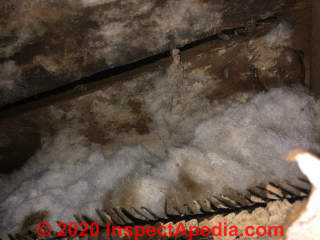 That looks like white fiberglass.
That looks like white fiberglass.
On 2020-07-23 by vc
Hello, was wondering if someone would help identify this type of insulation.
On 2018-07-27 - by (mod) -
Toni all of your comments are still included in this comment series on this page, though at some point they'll move to a FAQs page when the data begins to spill out of view.
There are some spray-on under-roof insulations that contained asbestos. If you know the age of the insulation in your building or even the age of the building you can generally rule such a worry in or out. If your building was constructed or its insulation sprayed after 1973 it should not contain asbestos spray-on insulation nor asbestos-based spray-on fire-resistant coatings.
In 1973, under the EPA's Clean Air Act, most spray-applied asbestos products were banned for fireproofing and insulating purposes.
On 2018-07-27 by Toni
Did my comment before the last picture go through?
The one where I answered your questions.
On 2018-07-26 - by (mod) -
Sorry I don't know what that is; it looks like a peeling plastic coating on something.
On 2018-07-26 by Toni
Dang, that last one is blurry too.
Here is another.
IMAGE LOST by older version of Clark Van Oyen’s useful Comments code - now fixed. Please re-post the image if you can. Sorry. Mod.
On 2018-07-26 by Toni
Sorry about the photo, it looked clearer on my end. I'll send another.
The material is thin, white, looks plastic-y, and has what looks like bubble wrap shapes where the top layer has been disturbed.
I'm not sure about the age of the building, but I could probably find out, if necessary.
The location is in Sonoma County, United States.
My co-worker told me it has been sagging and falling off since she has been working there (6 years).
That is a light fixture and our roof does indeed leak.
My dad said it's some sort of insulation used in unfinished buildings.
The wind, our air system, and even nothing, makes it fall to the ground.
When we go to pick it up, it practically disintegrates.
IMAGE LOST by older version of Clark Van Oyen’s useful Comments code - now fixed. Please re-post the image if you can. Sorry. Mod.
On 2018-07-24 - by (mod) -
Toni
I really can't say what that is from such a blurry photo but it may be a plaster coating on top of a metal or plastic lath. It would be helpful to know the age of the building, its country and city of location, and perhaps to see some sharper images.
It would also be useful to investigate the reason that the ceiling coating is falling-off: for example if there are leaks above there could be other damage or hazards, including wet electrical wiring if that's a light fixture in your image.
On 2018-07-24 by Toni: help asap!
What is this material hanging from my works ceiling?
My dad, who is a contractor, saw it and said it's bad and that we are breathing it in. It falls to the ground and crumbles when you go to pick it up.
IMAGE LOST by older version of Clark Van Oyen’s useful Comments code - now fixed. Please re-post the image if you can. Sorry. Mod.
On 2018-04-29 - by (mod) -
Lee
You'll want to review ASBESTOS PAPER DUCT INSULATION
I would be stunned if your ducts were actually simply asbestos paper. More-likely they're metal duct with paper wrapping, or less liklely, cement-asbestos (which would not be paper-wrapped) transite duct material.
[Use the Picture Fram icon next to the Comment button to attach photos = one by one - to comments so we can take a look. ]
Asbstos paper was not often used on the interior of ducts nor of supply registers or supply register boxes, but it's worth taking a look-see. You'd simply remove the (usually two) screws holding the register grille in place, shine a light into the duct register box, and take some sharp photos for us to see.
At the article I recommended you'll read that asbestos paper wrap on an air SUPPLY duct EXTERIOR is of little risk if it's intact, since supply ducts are under positive pressure. You'd seal, paint, or encapsulate, or if ducts for other reasons needed to be replaced, you'd replace entire sections. It would never make economic sense to pay to simply remove the asbestos-based paper.
On return ducts, asbestos paper over holes in the ductwork could be a (small but real) potential hazard - we'd need to know more about your system to comment.
Look and learn what's there before letting some fool start tearing anything apart.
On 2018-04-29 by Lee by the Sea
Our house is a one-story wood-frame bungalow in coastal Southern California, built in 1954. It has forced-air heating with cylindrical asbestos paper ducts. Each duct ends at an adapter that guides the hot air into the space between two studs and above a door header. That space is closed up by lath and plaster on either side, forming a box-like space.
A hole cut in the plaster lets the air out through a louvered vent. // I was told by a heating salesman that asbestos material was probably used to line the inside of the box-like space, so it should be sealed off and not used when the asbestos paper ducts and asbestos-cement adapters are abated and replaced with modern ducting. Is such asbestos lining actually used like that? How can that be determined? Can asbestos lining be abated? Is there any way to get air to the vents without abating such asbestos lining?
Question: is the asbestos insulation in my home dangerous?
I have a question about some recent reno work done at my family cottage. The cottage was built in the late fifties and added on to in subsequent years. Recently, we had a new roof installed. We decided to remove an old oil heater. The roofers removed the chimney pipe. It was quite difficult to get out so they were quite rough handling it.
My question, now that I look at the hole in the ceiling has to do with asbestos drywall. The ceiling tiles are likely asbestos containing but where the pipe had been installed looked like drywall. I have read about asbestos insulating board and asbestos containing drywall and now am very concerned that there may be asbestos dust. I have read that insulating board has a higher asbestos content than the asbestos drywall, and is therefore more dangerous (40% asbestos in the insulating board?). Is this true?
And how can we tell the difference between insulating board and drywall? I don't see any fibres sticking out at the rough edges, if that makes a difference. I am concerned as we regularly take my 1.5year old son there as well. Any help you can provide would be greatly appreciated. Your website has already helped me on many occassions! - B. 8/29/2013
Reply:
I'm not familiar with an "asbestos drywall" product, though certainly some drywall and some joint compounds contained asbestos and asbestos was used in textured paints that in turn may have been applied to drywall based ceilings and walls.. Drywall is principally a gypsum product, paper covered on both sides, and is comparatively soft - it can be cut with a utility knife or "drywall knife". Drywall is made in thickness from about 1/8" to 5/8".
Cement board or asbestos-cement board is a hard, cementious product, not paper coated, typically thinner (maybe 1/8 to 3/16" thick) and thus not nearly as friable as drywall or drywall compound; But if someone runs a power tool like a saw, grinder, or does a lot of pounding demolition, indeed one might make a dusty mess that could contain asbestos.
At our asbestos products photo guide and in the FAQs at the end of that article https://InspectAPedia.com/hazmat/Asbestos_Materials_Photo_Guide.php I've added photos of cement asbestos millboard and drywall to help you see how easily one can distinguish between these materials.
For a very different product that is easily distinguished from drywall as well as from cement asbestos sheet products, take a look at the widely used brown insulating board applied both as building sheathing and as interior wall coverings - described
Reader follow-up:
Thank you so much for your reply. So when they refer to asbestos insulation board (AIB?)they are referring to a cementious board then? Okay, I will try to get some pictures taken of said hole before they cover it up. I'm trying to figure out whether to tell them it is okay to screw into or not. I wasn't there the day the metal pipe was bashed out but my mother was and she said there was no visible dust or anything like that. The board has been painted all these years. The exposed sides look like drywall to me but I am no expert.
Was drywall that contained asbestos uncommon? Did it typically have a low or high percentage in it? Thank you so much Your website is fantastic by the way Oh and I do have a question about the floor tiles in the bathroom where the floor is sagging and needs repair. I would guess they have asbestos but I couldn't find them in all the photos in your tile section. I will send a picture.....as soon as I figure out how......Your site did have pictures of the tiles that cover practically the whole cottage though....all asbestos containing of course.
Reply:
Not necessarily. Who are "they" ? There were thousands of asbestos products, including some nearly pure tremololite asbestos that was more dangerous and not a cementious product - i just don't have enough specifics to be able to answer your question with confidence.
Reader Follow-up:
By "they" I just meant all the websites that mention it. I will try to get a picture of it this weekend. It seems like the more I find out the more disturbing it is...how many people must be unknowingly exposed to it all the time doing home renis and such...ugh.
Reply:
I don't mean to be irritating about this but sloppy use of product terms and language, while common among people who are not experts, can be confusing and very costly - unnecessarily. For example, there are some soft asbestos insulation boards that are quite hazardous and need professional removal; on the other hand, hard cement asbestos millboard, widely used in a number of applications and buildings, is cemetious, not friable, and not highly dangerous unless someone is using power tools to grind, saw, or make a dusty mess.
The exposure level for painted cement asbestos millboard is probably below the limits of detection in most cases and not something about which to panic.
Asbestos is safe and legal to remain in homes or public buildings as long as the asbestos materials are in good condition and the asbestos can not be released into the air. - US EPA
Do keep me posted and send along clarifying photos or followup reports if you can - that may permit me to comment further and be of further aid.
...
Continue reading at ASBESTOS ELECTRICAL WIRE INSULATION or select a topic from the closely-related articles below, or see the complete ARTICLE INDEX.
Or see these
Recommended Articles
- ASBESTOS BUILDING INSULATION - forms, types, locations of asbestos used as building insulation
- ASBESTOS FIREPROOFING SPRAY-On Coatings
- ASBESTOS IN MINERAL WOOL / STONE WOOL
- ASBESTOS INSULATION
- ASBESTOS STYROFOAM PANELS
- INSULATION IDENTIFICATION GUIDE identifying various insulation materials found in buildings.
Suggested citation for this web page
ASBESTOS INSULATION at InspectApedia.com - online encyclopedia of building & environmental inspection, testing, diagnosis, repair, & problem prevention advice.
Or see this
INDEX to RELATED ARTICLES: ARTICLE INDEX to ASBESTOS HAZARDS
Or use the SEARCH BOX found below to Ask a Question or Search InspectApedia
Ask a Question or Search InspectApedia
Try the search box just below, or if you prefer, post a question or comment in the Comments box below and we will respond promptly.
Search the InspectApedia website
Note: appearance of your Comment below may be delayed: if your comment contains an image, photograph, web link, or text that looks to the software as if it might be a web link, your posting will appear after it has been approved by a moderator. Apologies for the delay.
Only one image can be added per comment but you can post as many comments, and therefore images, as you like.
You will not receive a notification when a response to your question has been posted.
Please bookmark this page to make it easy for you to check back for our response.
IF above you see "Comment Form is loading comments..." then COMMENT BOX - countable.ca / bawkbox.com IS NOT WORKING.
In any case you are welcome to send an email directly to us at InspectApedia.com at editor@inspectApedia.com
We'll reply to you directly. Please help us help you by noting, in your email, the URL of the InspectApedia page where you wanted to comment.
Citations & References
In addition to any citations in the article above, a full list is available on request.
- Asbestos Identification, Walter C.McCrone, McCrone Research Institute, Chicago, IL.1987 ISBN 0-904962-11-3. Dr. McCrone literally "wrote the book" on asbestos identification procedures which formed the basis for current work by asbestos identification laboratories.
- Stanton, .F., et al., National Bureau of Standards Special Publication 506: 143-151
- Pott, F., Staub-Reinhalf Luft 38, 486-490 (1978) cited by McCrone
- Basic Information about Asbestos, US EPA, web search 08/17/2010, original source: http://www.epa.gov/asbestos/pubs/help.html
- "Handling Asbestos-Containing roofing material - an update", Carl Good, NRCA Associate Executive Director, Professional Roofing, February 1992, p. 38-43
- EPA Guidance for Controlling Asbestos-Containing Materials in buildings, NIAST, National Institute on Abatement Sciences & Technology, [republishing EPA public documents] 1985 ed., Exposure Evaluation Division, Office of Toxic Substances, Office of Pesticides and Toxic Substances, U.S. Environmental Protection Agency, Washington,D.C. 20460
- EPA, ASBESTOS IN YOUR HOME [PDF] - U.S. EPA, Exposure Evaluation Division, Office of Toxic Substances, Office of Pesticides and Toxic Substances, U.S. Environmental Protection Agency, Washington,D.C. 20460
- In addition to citations & references found in this article, see the research citations given at the end of the related articles found at our suggested
CONTINUE READING or RECOMMENDED ARTICLES.
- Carson, Dunlop & Associates Ltd., 120 Carlton Street Suite 407, Toronto ON M5A 4K2. Tel: (416) 964-9415 1-800-268-7070 Email: info@carsondunlop.com. Alan Carson is a past president of ASHI, the American Society of Home Inspectors.
Thanks to Alan Carson and Bob Dunlop, for permission for InspectAPedia to use text excerpts from The HOME REFERENCE BOOK - the Encyclopedia of Homes and to use illustrations from The ILLUSTRATED HOME .
Carson Dunlop Associates provides extensive home inspection education and report writing material. In gratitude we provide links to tsome Carson Dunlop Associates products and services.


